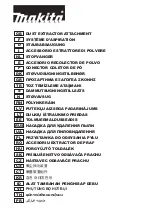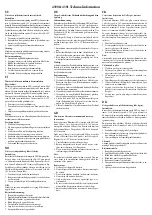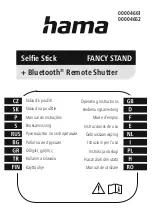
20
Installation
3.2 Installation check list
For a complete installation, proceed to the following actions following the instructions in this
manual very carefully:
1.
Install the 410 analyzer. Refer to
through
2.
Install the sensor in the sample pipe or flow chamber and connect it to the instrument. Refer
to
.
3.
Turn the instrument on and set the operating language. Refer to
4.
Enter the default login credentials “1007” for the ID and “1234” for the password. Refer to
.
5.
Change the default login and set the security levels, users ID’s and passwords. Refer to
.
6.
Verify that the sensor cap selected (i.e. low or high range: K/M1100-L or K/M1100-H)
corresponds to the sensor in use. Refer to
.
7.
The measurement liquid is set by default to water for the K1100 and M1100 high range
sensors, and beer for the M1100 low range sensor. For the M1100 low range sensor,
change this to water if the sample being measured is not beer. Refer to
.
8.
Enable thermal cutoff and set it to the minimum possible value (e.g. 10°C if the liquid in the
sample line is at 0-5°C). This is critical to ensure long-term stability. Refer to
.
9.
Set the measurement interval according to your response time needs. Refer to
.
10.
Enable the calibration timer and set the number of days to 180 days (6 months) or
according to your quality needs to ensure a regular sensor calibration. Refer to
.
11.
Enable the service timer and set the number of days to 360 days (1 year) or according to
your quality needs to ensure a regular sensor service. Refer to
.
12.
If required, program the relay and analog outputs to ensure an event is set when a
calibration or service is required. These can be programmed for each as custom events.
Refer to
. Note that when a calibration or service timer has expired, the
instrument will automatically display this information as a warning message. Refer to the
table
.
As the system is factory calibrated and does not require an initial calibration. Refer to
for more details. The instrument and sensor should now be ready
for operation. If a problem occurs, refer to
. If the difficulty cannot
be overcome, please contact your Hach representative who will be happy to assist you.
Summary of Contents for ORBISPHERE K-M1100
Page 5: ...4 Table of Contents ...
Page 19: ...18 Specifications ...
Page 39: ...38 Installation ...
Page 45: ...44 User Interface ...
Page 48: ...47 Section 6 View Menu Figure 33 View menu ...
Page 51: ...50 View Menu ...
Page 52: ...51 Section 7 Measurement Menu Figure 36 Measurement menu ...
Page 59: ...58 Measurement Menu ...
Page 65: ...64 Calibration Menu ...
Page 66: ...65 Section 9 Inputs Outputs Menu Figure 39 Inputs Outputs menu ...
Page 68: ...67 Inputs Outputs Menu 9 4 Analog outputs Figure 40 Analog outputs menu ...
Page 75: ...74 Inputs Outputs Menu ...
Page 91: ...90 Communication Menu ...
Page 94: ...93 Section 12 Products Menu Figure 43 Products menu ...
Page 97: ...96 Global Configuration Menu ...
Page 98: ...97 Section 14 Services Menu Figure 45 Services menu part 1 ...
Page 99: ...98 Services Menu Figure 46 Services menu part 2 ...
Page 107: ...106 Maintenance and Troubleshooting ...
Page 113: ...112 Accessories and Spare Parts ...
















































